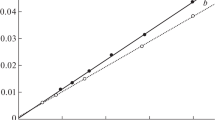Abstract
The optimal separation of peaks in column chromatography is derived from information theory based on FUM1. The optimal is shown to be described by the chromatographic resolution Rs. The information theory of column chromatography demonstrates that optimization based on FUMI can entail optimization on Rs as a special case. The peak capacity can also be derived theoretically from FUMI.
Similar content being viewed by others
References
Y. Hayashi, S. Yoshioka and Y. Takeda, Anal Sci., 5, 329 (1989).
Y. Hayashi and R. Matsuda, Anal. Chim, Acta, 222, 313 (1989).
Y. Hayashi, Anal. Sci., 6, 15 (1990).
D. L. Massart, B. G. M. Vandeginste, S. N. Deming, Y. Michotte and L. Kaufman, “Chemometrics: a textbook”, Elsevier, Amsterdam, 1988.
H. J. G. Debets, B. L. Bajema and D. A. Doornbos, Anal. Own. Acta. 151, 131 (1983).
C. E. Goewie, J. Liq. Chromatogr., 9, 1431 (1985).
P. J. Schoenmakers, J. Liq. Chromatogr., 10, 1865 (1987).
J. L. Glajch, J. J. Kirkland and J. M. Minor, J. Liq. Chromatogr., 10, 1727 (1987).
J. M. Giddings, Anal. Cherru, 39, 1027 (1967).
S. Arimoto, “Johou Riron (Information Theory, in Japanese)”, Kyoritsu Shuppan, Tokyo, 1976.
Y. Hayashi, S. Yoshioka and Y. Takeda, Anal. Chim. Acta, 212, 81 (1988).
Y. Hayashi, R. Matsuda, S. Yoshioka and Y. Takeda, Anal. Chim. Acta, 209, 45 (1988).
R. Matsuda, Y. Hayashi, M. Ishibashi and Y. Takeda, J. Chromatogr., 462, 13 (1989).
R. Matsuda, Y. Hayashi, M. Ishibashi and Y. Takeda, J. Chromatogr., 462, 23 (1989).
Y. Hayashi, T. Shibazaki, R. Matsuda and M. Uchiyama, J. Chromatogr., 407, 59 (1987).
Y. Hayashi, T. Shibazaki and M. Uchiyama, Anal. Chim. Acta, 201, 185 (1987).
Y. Hayashi, T. Shibazaki, R. Matsuda and M. Uchiyama, Anal Chim. Acta, 202, 187 (1987).
Y. Hayashi, T. Shibazaki and M. Uchiyama, J. Chromatogr., 411, 95 (1987).
“Kosoku Ekitai Kuromatogurqfu Bunseki (High Performance Liquid Chromatography, in Japanese)”, ed. The Japan Society for Analytical Chemistry, Kanto Region Branch, Sangyo Tosho, Tokyo, 1982.
R. Matsuda, Y. Hayashi, M. Ishibashi and Y. Takeda, Anal. Chim. Acta, 222, 301 (1989).
Y. Hayashi and R. Matsuda, Anal. Sci, 5, 459 (1989).
Y. Hayashi and R. Matsuda, submitted for publication.
Y. Hayashi and R. Matsuda, submitted for publication.
Author information
Authors and Affiliations
Rights and permissions
About this article
Cite this article
Hayashi, Y. Optimal Peak Separation Derived from Information Theory of Chromatography. ANAL. SCI. 6, 257–260 (1990). https://doi.org/10.2116/analsci.6.257
Received:
Accepted:
Published:
Issue Date:
DOI: https://doi.org/10.2116/analsci.6.257




